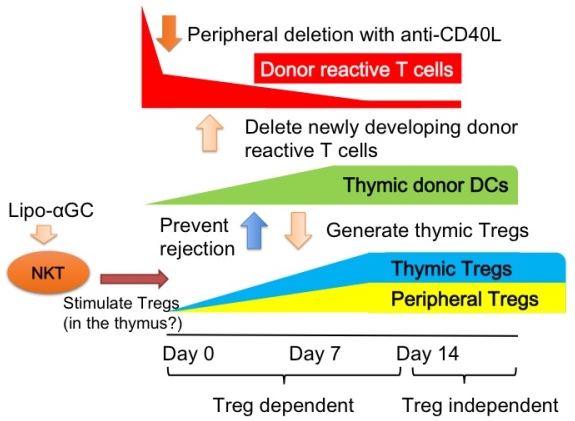iNKT Cell Activation Under Co-Stimulatory Blockade Establishes Mixed Chimerism Through Thymic Regulatory T Cell Activation.
1Department of Urology, Tokyo Women's Medical University, Shinjuku, Tokyo, Japan
2Laboratory for Vaccine Design, RIKEN-IMS, Yokohama, Kanagawa, Japan.
Meeting: 2016 American Transplant Congress
Abstract number: B33
Keywords: Bone marrow transplantation, Mixed chimerism, Thymus, Tolerance
Session Information
Session Name: Poster Session B: Allograft Rejection, Tolerance, and Xenotransplantation
Session Type: Poster Session
Date: Sunday, June 12, 2016
Session Time: 6:00pm-7:00pm
 Presentation Time: 6:00pm-7:00pm
Presentation Time: 6:00pm-7:00pm
Location: Halls C&D
Background: Invariant natural killer T (iNKT) cells have recently garnered considerable attention for their potential to induce regulatory T cells (Tregs). We previously reported a novel approach for inducing mixed hematopoietic chimerism by activation of iNKT cells using liposomal α-galactosylceramide (lipo-aGC) combined with a CD40/CD40L blockade in a sub-lethally irradiated murine bone marrow transplant (BMT) model. Because Treg depletion before BMT resulted in the chimerism brake, there should be an interaction between iNKT cells and Tregs; however, the mechanisms by which iNKT cells expand Tregs remains to be elucidated. Therefore, in this study, we performed a quantitative and functional analysis of splenic and thymic Tregs in a murine BMT model.
Methods and Results: After 3-Gy irradiation, recipient BALB/c mice underwent BMT from a fully allogeneic B6 donor, and were subsequently treated with lipo-aGC plus anti-CD40L mAb. All mice treated with this regimen showed engraftment of donor cells from day 7, and established robust mixed hematopoietic chimerism on day 14. We analyzed Tregs in the spleen and the thymus by flow cytometry on day 7 after BMT. The number of splenic Tregs of the chimeric mice increased significantly with high expression of Ki67. However, the thymic Tregs of chimeras did not increase, although they showed up-regulation of Ki67. Both splenic and thymic Tregs that were obtained from chimeric mice on day 7 after BMT suppressed proliferation of naive BALB/c T cells against donor antigen in vitro; however, neither of these cells suppressed proliferation against 3rd party antigens. Interestingly, when recipient mice underwent thymectomy before BMT, they failed to expand Tregs in the spleen, and resulted in the chimerism brake.
Conclusion: These data collectively suggest that iNKT cells stimulated with lipo-aGC plus anti-CD40L mAb interact with thymic Tregs required for peripheral Treg expansion and establishment of mixed chimerism. 
CITATION INFORMATION: Hirai T, Ishii Y, Ishii R, Miyairi S, Ikemiyagi M, Okumi M, Tanabe K. iNKT Cell Activation Under Co-Stimulatory Blockade Establishes Mixed Chimerism Through Thymic Regulatory T Cell Activation. Am J Transplant. 2016;16 (suppl 3).
To cite this abstract in AMA style:
Hirai T, Ishii Y, Ishii R, Miyairi S, Ikemiyagi M, Okumi M, Tanabe K. iNKT Cell Activation Under Co-Stimulatory Blockade Establishes Mixed Chimerism Through Thymic Regulatory T Cell Activation. [abstract]. Am J Transplant. 2016; 16 (suppl 3). https://atcmeetingabstracts.com/abstract/inkt-cell-activation-under-co-stimulatory-blockade-establishes-mixed-chimerism-through-thymic-regulatory-t-cell-activation/. Accessed December 20, 2025.« Back to 2016 American Transplant Congress
